Cable Force Calculation of Cable Hoisting of CFST Arch Bridge Research
Abstract
:1. Introduction
2. Calculation of Arch Rib Cable Force
2.1. Calculation Principle
2.2. Calculation Method
3. Engineering Application
3.1. Engineering Situations
3.2. The Finite Element Model Calculation
3.3. Bridge Linear Calculation
3.4. Internal Force of Bridge Arch in Bare Arch State
4. Analysis of Effect
4.1. Analysis of Cable Force
4.2. Arch Rib Elevation Analysis
4.3. Stress Analysis of Arch Rib
5. Conclusions
Author Contributions
Funding
Conflicts of Interest
References
- Lai, X.Y.; Chen, B.C. A comparative analysis on two creep prediction models for CFST arch bridge. J. Fuzhou Univ. 2014, 42, 737–743. [Google Scholar]
- Chen, B.; Wei, J.; Zhou, J.; Liu, J.P. Application of concrete-filled steel tube arch bridges in China: Current status and prospects. China Civ. Eng. J. 2017, 50, 50–61. [Google Scholar]
- Gao, Y.Q.; Zhai, P.C. Construction Control of Arch Rib Hoisting of Long Span Concrete Filled Steel Tube Arch Bridge; Theory & Practice for Reform of Civil & Architecture Education Editorial Department, Wuhan University of Technology Press: Wuhan, China, 2009; pp. 92–95. [Google Scholar]
- Chen, B.C.; Wei, J.G.; Wu, Q.X. Design Calculation Method and Application of Concrete Filled Steel Tube Arch Bridge; China Construction Industry Press: Beijing, China, 2014. [Google Scholar]
- Meng, Y.S. Research on the Application of Concrete Filled Steel Tube Arch Bridge Construction Technology. Constr. Des. Eng. 2022, 16, 197–199. [Google Scholar]
- Xu, F. Installation construction technology of steel pipe arch of Wumei River Bridge. Highway 2022, 67, 221–225. [Google Scholar]
- Zhang, Z.C.; Ye, G.R.; Wang, Y.F. Optimization of stayed-buckle cable forces during adjustment of the line-shape on long span arch bridge. Eng. Mech. 2004, 6, 187–192. [Google Scholar]
- Liu, S.P.; Zhang, M.; Duan, Y.S. Cable force calculation of Daninghe bridge based on Zero-order optimization method. J. Munic. Technol. 2009, 27, 354–356+364. [Google Scholar]
- Zhou, Y.; Wang, Y.; Zhou, J.T.; Huang, Z.; Zhang, X.; Xiang, Z. Arch forming calculation theory and control method of 500 m steel tube arch bridge. China J. Highw. Transp. 2022, 35, 60–72. [Google Scholar]
- Gu, Y.; Yao, C.R.; Li, Y.D.; Kang, L. Study of alignment control method for installation of arch ribs of long span CFST arch bridge. Bridge Constr. 2014, 44, 107–113. [Google Scholar]
- Ye, L.X.; Ke, H.J.; Chen, Z. Analysis of assembly stage of suspension bridge with steel box girder anchor based on Midas Civil. J. China Foreign Highw. 2020, 40, 140–145. [Google Scholar]
- Zhang, L. Long-Span Cable-Stayed Bridge Deck Linear Adjustment Technology Research. Ph.D. Thesis, Chongqing Jiaotong University, Chongqing, China, 2015. [Google Scholar]
- Hu, D.L.; Chen, D.S.; Zhao, X.Y.; Gong, J.P.; Li, Y. Construction control of cantilever casting of long span reinforced concrete arch bridge. J. Traffic Transp. Eng. 2016, 16, 25–36. [Google Scholar]
- Chen, D.L.; Miao, L.; Tian, Z.C.; Luo, Z.L. Calculation of the cable-stayed force and pre-camer in the process of assembling arch bridge segments. Eng. Mech. 2007, 5, 132–137. [Google Scholar]
- Wang, Q.A.; Dai, Y.; Ma, Z.G.; Ni, Y.Q.; Tang, J.Q.; Xu, X.Q.; Wu, Z.Y. Towards probabilistic data-driven damage detection in SHM using sparse Bayesian learning scheme. Struct. Control. Health Monit. 2022, 29, e3070. [Google Scholar] [CrossRef]
- Wang, Q.A.; Wang, C.B.; Ma, Z.G.; Chen, W.; Ni, Y.Q.; Wang, C.F.; Yan, B.G.; Guan, P.X. Bayesian dynamic linear model framework for SHM data forecasting and missing data imputation during typhoon events. Struct. Health Monit. Int. J. 2022, 21, 2933–2950. [Google Scholar] [CrossRef]
- Wang, Q.A.; Zhang, C.; Ma, Z.G.; Ni, Y.Q. Modelling and forecasting of SHM strain measurement for a large-scale suspension bridge during typhoon events using variational heteroscedasic Gaussian process. Eng. Struct. 2021, 251, 113554. [Google Scholar]
- Wang, Q.A.; Zhang, C.; Ma, Z.G.; Jiao, G.Y.; Jiang, X.W.; Ni, Y.Q.; Wang, Y.-C.; Du, Y.T.; Qu, G.B.; Huang, J. Towards long-transmission-distance and semi-active wireless strain sensing enabled by dual-interrogation-mode RFID technology. Struct. Control. Health Monit. 2022, 29, e3069. [Google Scholar] [CrossRef]
- Wang, Q.A.; Dai, Y.; Ma, Z.G.; Wang, J.F.; Lin, J.F.; Ni, Y.Q.; Ren, W.X.; Jiang, J.; Yang, X.; Yan, J.R. Towards high-precision data modeling of SHM measurements using an improved sparse Bayesian learning scheme with strong generalization ability. Struct. Health Monit. Int. J. 2023; online. [Google Scholar] [CrossRef]
- Zhu, L.W.; Deng, N.C.; Yu, M.S.; Guo, X. Research on formal iterative optimization algorithm for buckle cable force in 600 m class arch bridge construction by cable-stayed buckling method. Railw. Eng. 2020, 60, 18–21. [Google Scholar]
- He, B.T. Calculation of initial cable force of suspender of concrete filled steel tube arch bridge based on forward iteration method. Highw. Automot. Appl. 2022, 3, 110–111+134. [Google Scholar]
- Gao, J.; Chen, L.Y.; Wang, J.W. Optimization of tension force for hangers in multi-span tied-arch bridge based on influence matrix method. Highway 2022, 67, 165–170. [Google Scholar]
- JTGF80/1-2017; Meng, S.T. Inspection and Evaluation Quality Standards for Highway Engineering Section 1 Civil Engineering. Ministry of Transport of China: Beijing, China, 2018.
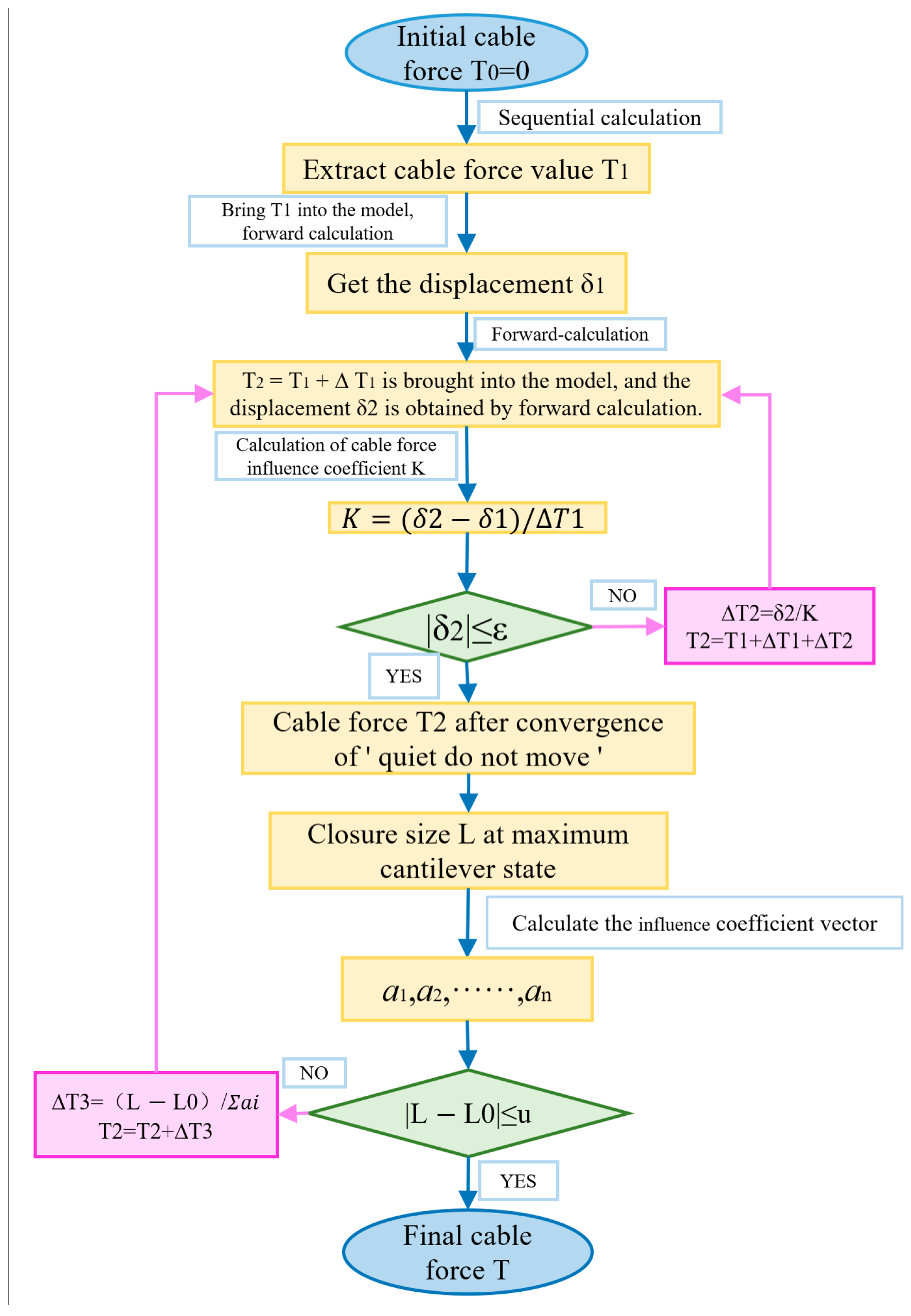
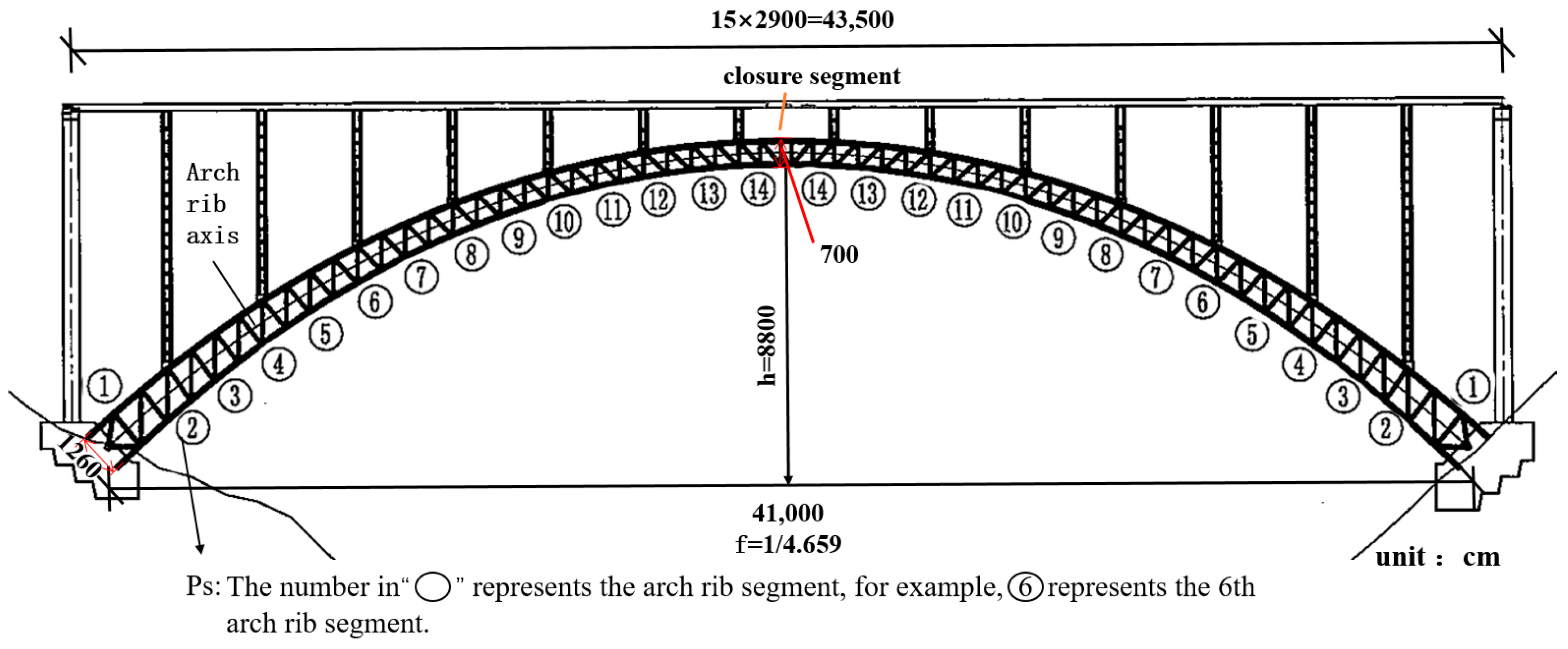

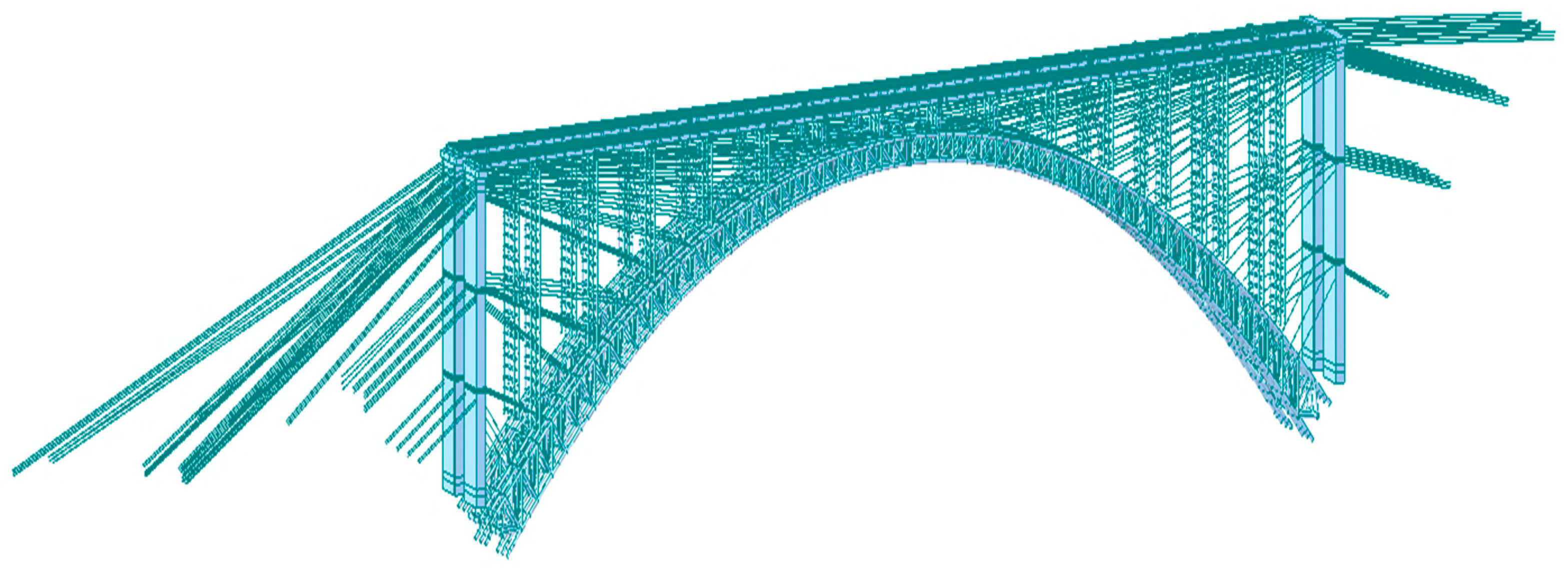
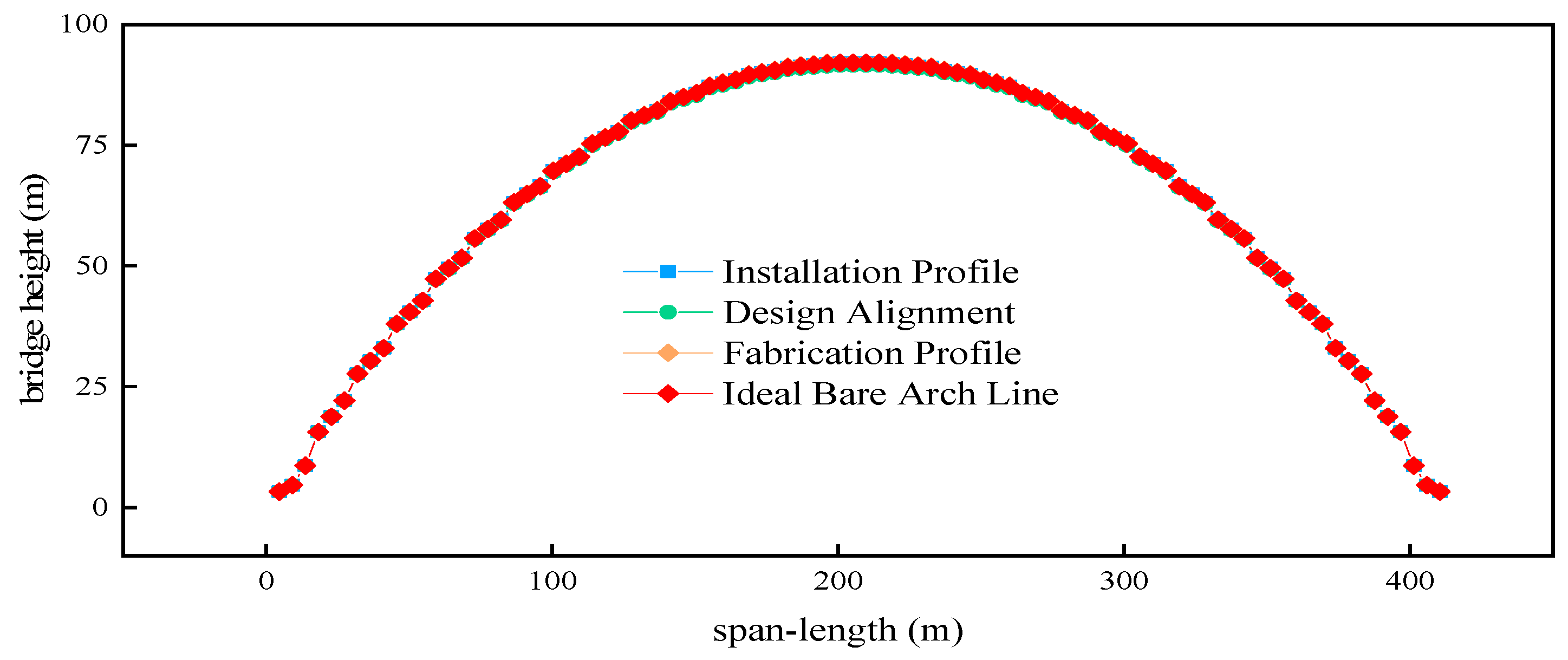



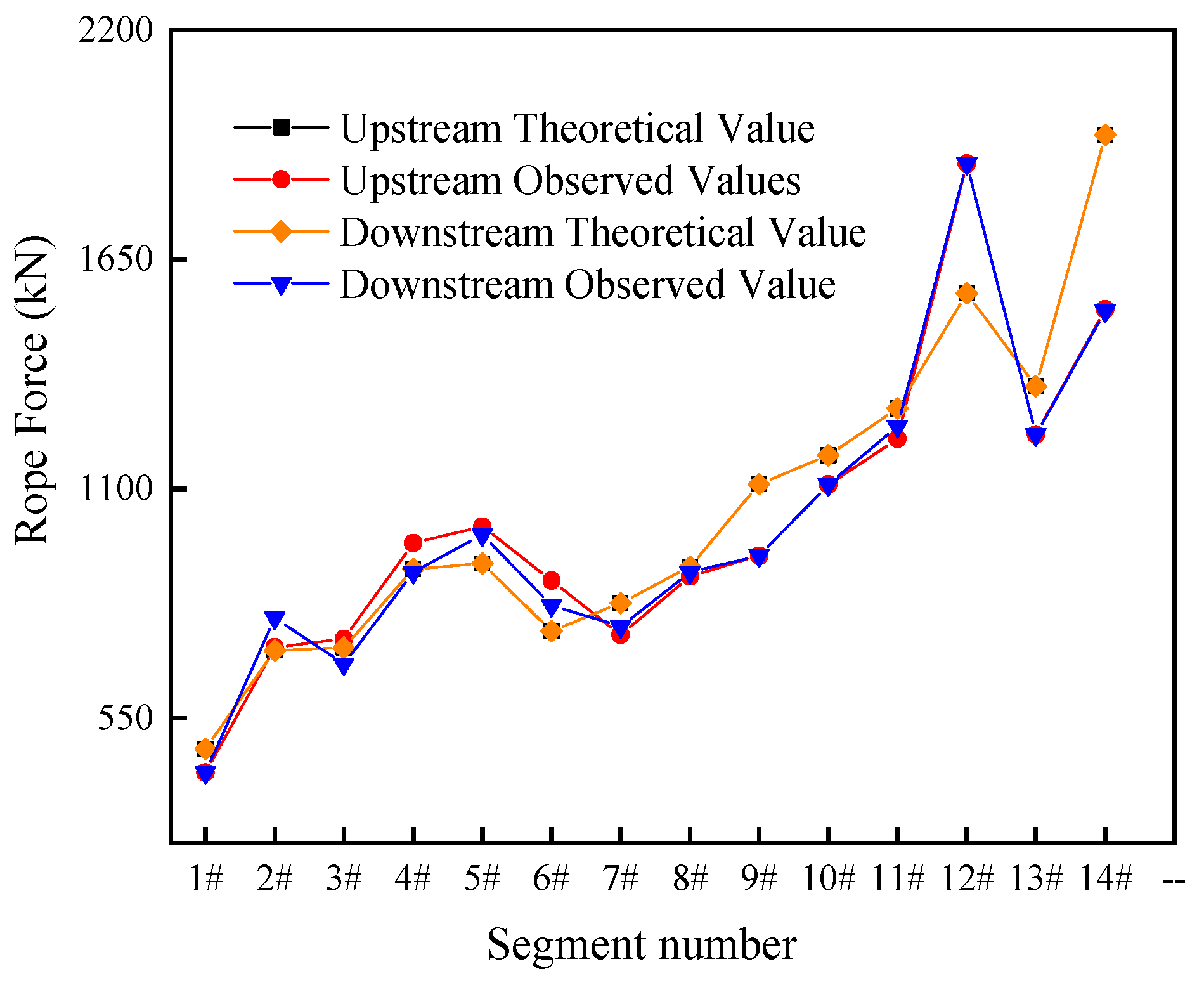
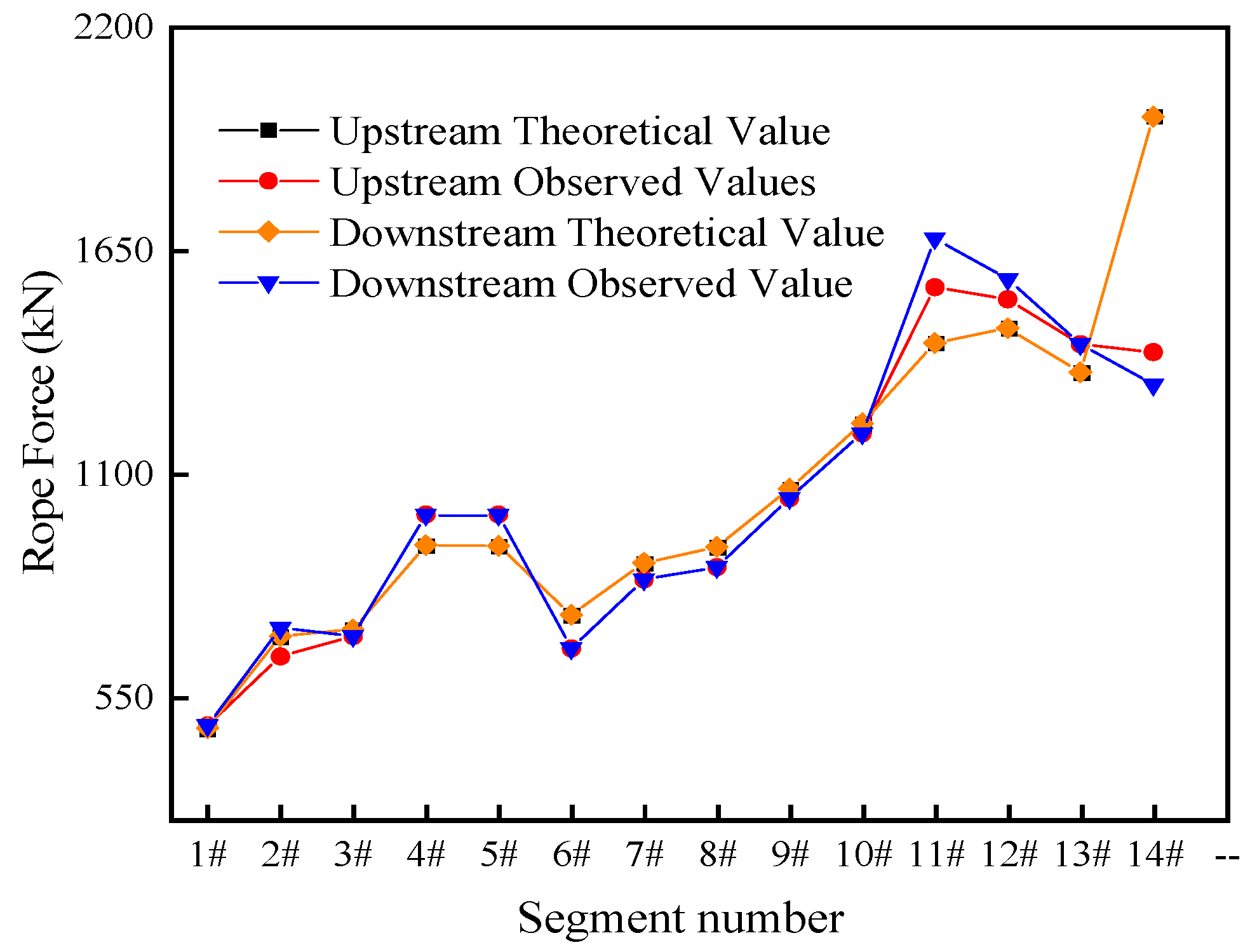



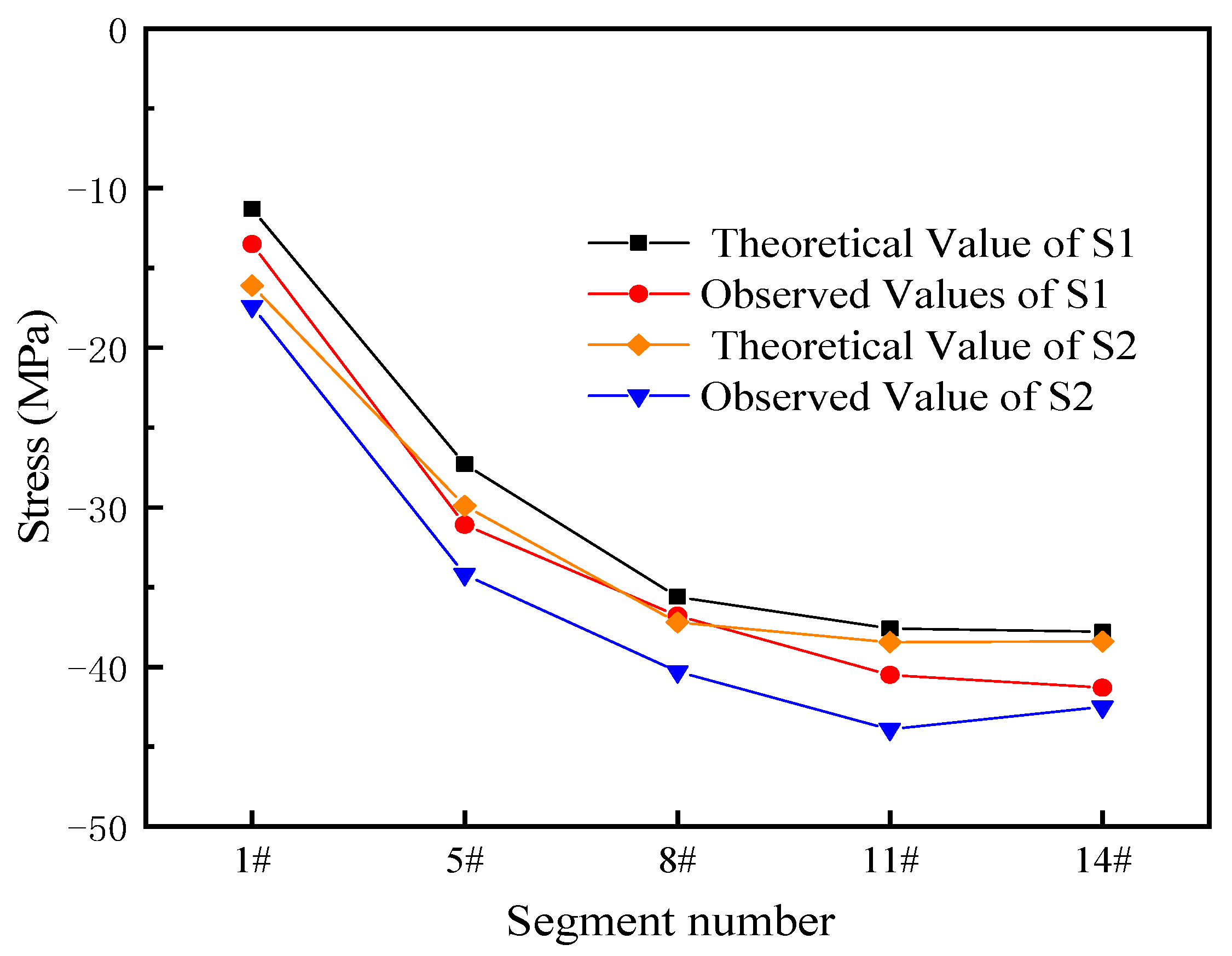
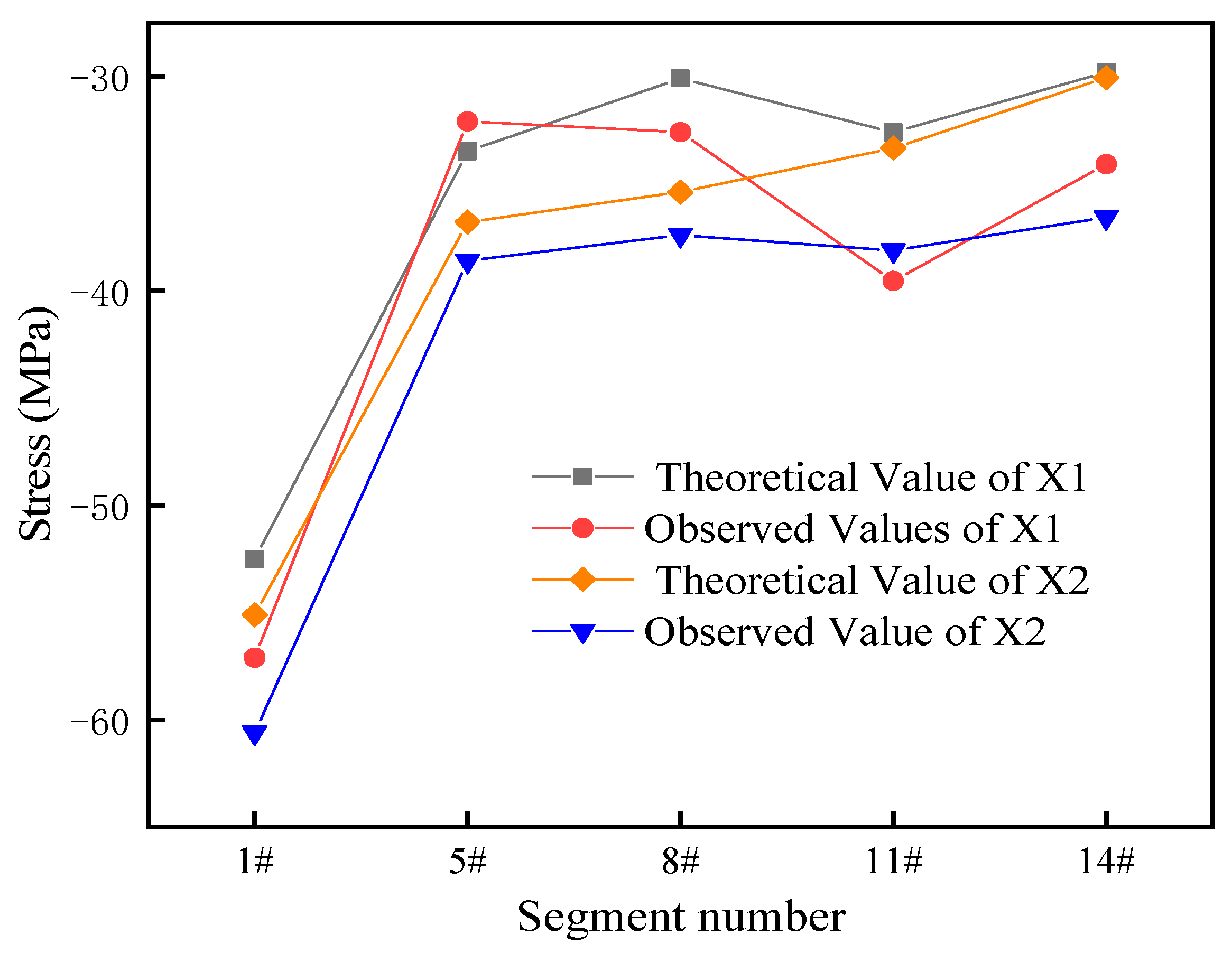
| Working Condition | Construction State | Working Condition | Construction State |
|---|---|---|---|
| 1 | Juncture pier | 22 | Tension buckle anchor cable KS8 |
| 2 | Segment 1 + buckle anchor cable KS1 | 23 | Support MC5 |
| 3 | Pouring arch foot oblique web member and hinge shaft concrete | 24 | Arch foot sealing |
| 4 | Arch foot K brace KC2 | 25 | Segment 9 |
| 5 | Segment 2 | 26 | Tension buckle anchor cable KS9 |
| 6 | Tension buckle anchor cable KS2 | 27 | Segment 10 |
| 7 | Support MC1 | 28 | Tension buckle anchor cable KS10 |
| 8 | Segment 3 | 29 | Support MC6 |
| 9 | Tension buckle anchor cable KS3 | 30 | Segment 11 |
| 10 | Support MC2 | 31 | Tension buckle anchor cable KS11 |
| 11 | Segment 4 | 32 | Segment 12 |
| 12 | Tension buckle anchor cable KS4 | 33 | Tension buckle anchor cable KS12 |
| 13 | Support MC3 | 34 | Support MC7 |
| 14 | Segment 5 | 35 | Segment 13 |
| 15 | Tension buckle anchor cable KS5 | 36 | Tension buckle anchor cable KS13 |
| 16 | Segment 6 | 37 | Segment 14 |
| 17 | Tension buckle anchor cable KS6 | 38 | Tension buckle anchor cable KS14 |
| 18 | Support MC4 | 39 | Support MC8 |
| 19 | Segment 7 | 40 | Arch top K brace KC1 |
| 20 | Tension buckle anchor cable KS7 | 41 | closure segment |
| 21 | Segment 8 | 42 | Disconnecting anchor cable |
| Construction Stage | Position | Upper Arch Rib/MPa | Lower Arch Rib/MPa |
|---|---|---|---|
| Bare arch state | arch abutment | −16.1 | −55.1 |
| L/8 | −29.9 | −36.8 | |
| L/4 | −37.2 | −35.35 | |
| 3 L/8 | −38.45 | −33.35 | |
| arch vault | −39.1 | −31.2 |
| Segment Number | KS1 | KS2 | KS3 | KS4 | KS5 | KS6 | KS7 | KS8 | KS9 | KS10 | KS11 | KS12 | KS13 | KS14 |
|---|---|---|---|---|---|---|---|---|---|---|---|---|---|---|
| 1# | 473.0 | |||||||||||||
| 2# | 467.8 | 735.3 | ||||||||||||
| 3# | 467.3 | 731.3 | 740.5 | |||||||||||
| 4# | 470.8 | 737.8 | 746.6 | 867.2 | ||||||||||
| 5# | 478.6 | 755.2 | 767.3 | 887.8 | 877.8 | |||||||||
| 6# | 488.8 | 779.7 | 797.0 | 922.3 | 909.7 | 683.1 | ||||||||
| 7# | 497.1 | 799.5 | 822.4 | 953.0 | 939.5 | 718.0 | 799.6 | |||||||
| 8# | 501.1 | 808.8 | 835.9 | 971.8 | 960.3 | 745.3 | 827.3 | 798.8 | ||||||
| 9# | 506.4 | 817.6 | 846.2 | 984.7 | 974.1 | 764.2 | 846.9 | 817.2 | 1066.6 | |||||
| 10# | 503.7 | 808.8 | 837.3 | 977.9 | 971.6 | 766.6 | 853.6 | 826.7 | 1077.3 | 1083.7 | ||||
| 11# | 500.0 | 794.8 | 820.9 | 961.3 | 959.5 | 758.2 | 850.4 | 827.8 | 1081.1 | 1090.4 | 1336.3 | |||
| 12# | 497.4 | 777.1 | 803.5 | 939.3 | 939.5 | 745.1 | 841.5 | 823.3 | 1080.3 | 1093.0 | 1340.9 | 1428.4 | ||
| 13# | 492.3 | 751.4 | 771.4 | 900.1 | 903.4 | 711.0 | 813.8 | 802.6 | 1066.1 | 1080.4 | 1332.8 | 1421.9 | 1218.9 | |
| 14# | 484.8 | 711.6 | 717.3 | 831.0 | 836.1 | 638.6 | 748.6 | 747.0 | 1020.3 | 1029.0 | 1289.1 | 1379.5 | 1188.5 | 1729.4 |
| closure segment | 482.8 | 708.9 | 712.0 | 828.9 | 838.2 | 641.6 | 756.2 | 758.3 | 1034.6 | 1052.1 | 1315.9 | 1412.7 | 1216.2 | 1761.8 |
| Segment Number | KS1 | KS2 | KS3 | KS4 | KS5 | KS6 | KS7 | KS8 | KS9 | KS10 | KS11 | KS12 | KS13 | KS14 |
|---|---|---|---|---|---|---|---|---|---|---|---|---|---|---|
| 1# | 471.6 | |||||||||||||
| 2# | 465.4 | 745.7 | ||||||||||||
| 3# | 462.6 | 736.2 | 751.7 | |||||||||||
| 4# | 467.9 | 746.6 | 762.3 | 873.3 | ||||||||||
| 5# | 476.3 | 764.8 | 783.3 | 891.8 | 918.9 | |||||||||
| 6# | 486.7 | 788.7 | 814.1 | 923.3 | 947.7 | 698.1 | ||||||||
| 7# | 496.1 | 810.3 | 841.9 | 953.0 | 976.0 | 731.0 | 815.1 | |||||||
| 8# | 501.2 | 821.8 | 857.6 | 971.9 | 996.4 | 756.5 | 840.8 | 814.9 | ||||||
| 9# | 508.5 | 834.0 | 871.0 | 986.1 | 1010.7 | 774.8 | 859.3 | 832.1 | 1097.1 | |||||
| 10# | 506.2 | 825.5 | 863.1 | 980.8 | 1009.1 | 777.8 | 866.0 | 841.1 | 1107.0 | 1109.7 | ||||
| 11# | 502.5 | 811.1 | 845.8 | 965.2 | 997.7 | 769.0 | 862.0 | 841.0 | 1109.4 | 1114.8 | 1381.5 | |||
| 12# | 500.5 | 793.8 | 829.5 | 946.3 | 980.4 | 757.7 | 854.4 | 837.3 | 1109.1 | 1117.8 | 1386.3 | 1463.2 | ||
| 13# | 496.3 | 767.8 | 799.2 | 912.0 | 948.4 | 728.7 | 830.8 | 819.8 | 1097.1 | 1106.3 | 1379.1 | 1457.5 | 1246.8 | |
| 14# | 488.7 | 726.3 | 742.9 | 847.5 | 885.9 | 661.1 | 770.2 | 768.2 | 1054.7 | 1053.5 | 1334.0 | 1413.5 | 1219.3 | 1767.1 |
| closure segment | 486.1 | 723.5 | 736.2 | 845.1 | 887.8 | 662.8 | 776.4 | 778.0 | 1067.4 | 1076.3 | 1360.5 | 1446.4 | 1243.0 | 1799.0 |
| Segment Number | The Hollow Steel Pipe Falls Once/m | Buckle/m | Difference/m |
|---|---|---|---|
| 1# | −0.004 | −0.009 | 0.005 |
| 2# | −0.009 | −0.014 | 0.004 |
| 3# | −0.017 | −0.019 | 0.002 |
| 4# | −0.025 | −0.023 | −0.002 |
| 5# | −0.034 | −0.026 | −0.007 |
| 6# | −0.043 | −0.031 | −0.013 |
| 7# | −0.053 | −0.035 | −0.018 |
| 8# | −0.062 | −0.04 | −0.022 |
| 9# | −0.071 | −0.046 | −0.025 |
| 10# | −0.078 | −0.053 | −0.025 |
| 11# | −0.084 | −0.063 | −0.021 |
| 12# | −0.09 | −0.077 | −0.013 |
| 13# | −0.095 | −0.095 | 0.001 |
| 14# | −0.098 | −0.124 | 0.027 |
| Key Sections | Rib Segment |
|---|---|
| arch feet | 1# |
| L/8 | 5# |
| L/4 | 8# |
| 3 L/8 | 11# |
| arch roof | 14# |
Disclaimer/Publisher’s Note: The statements, opinions and data contained in all publications are solely those of the individual author(s) and contributor(s) and not of MDPI and/or the editor(s). MDPI and/or the editor(s) disclaim responsibility for any injury to people or property resulting from any ideas, methods, instructions or products referred to in the content. |
© 2023 by the authors. Licensee MDPI, Basel, Switzerland. This article is an open access article distributed under the terms and conditions of the Creative Commons Attribution (CC BY) license (https://creativecommons.org/licenses/by/4.0/).
Share and Cite
Jia, Y.; Wei, C.; Huang, Z.; Li, Q.; Liao, P.; Lin, W. Cable Force Calculation of Cable Hoisting of CFST Arch Bridge Research. Buildings 2023, 13, 2370. https://doi.org/10.3390/buildings13092370
Jia Y, Wei C, Huang Z, Li Q, Liao P, Lin W. Cable Force Calculation of Cable Hoisting of CFST Arch Bridge Research. Buildings. 2023; 13(9):2370. https://doi.org/10.3390/buildings13092370
Chicago/Turabian StyleJia, Yi, Chaokuan Wei, Ziqiu Huang, Qi Li, Ping Liao, and Wencong Lin. 2023. "Cable Force Calculation of Cable Hoisting of CFST Arch Bridge Research" Buildings 13, no. 9: 2370. https://doi.org/10.3390/buildings13092370
APA StyleJia, Y., Wei, C., Huang, Z., Li, Q., Liao, P., & Lin, W. (2023). Cable Force Calculation of Cable Hoisting of CFST Arch Bridge Research. Buildings, 13(9), 2370. https://doi.org/10.3390/buildings13092370




